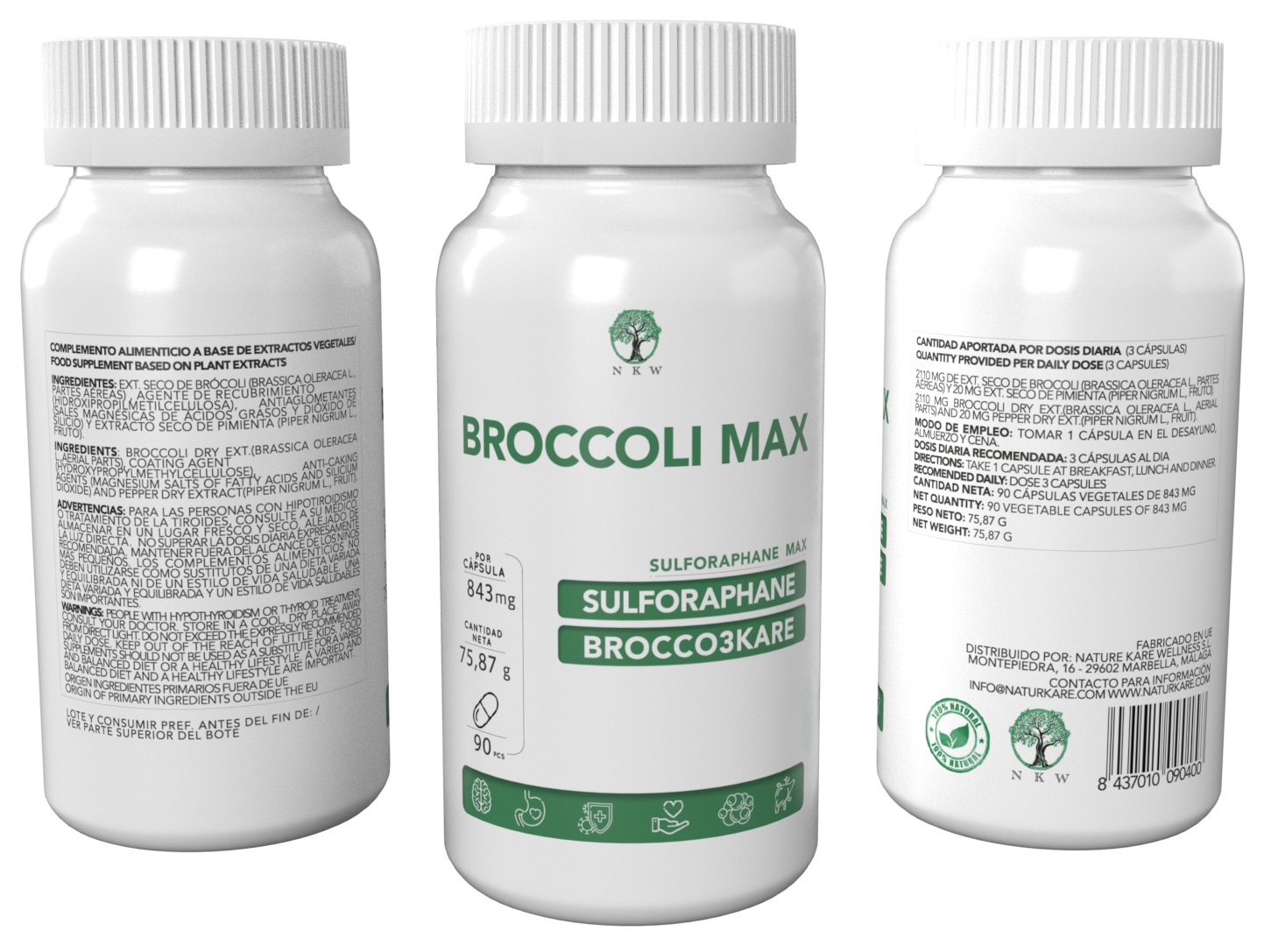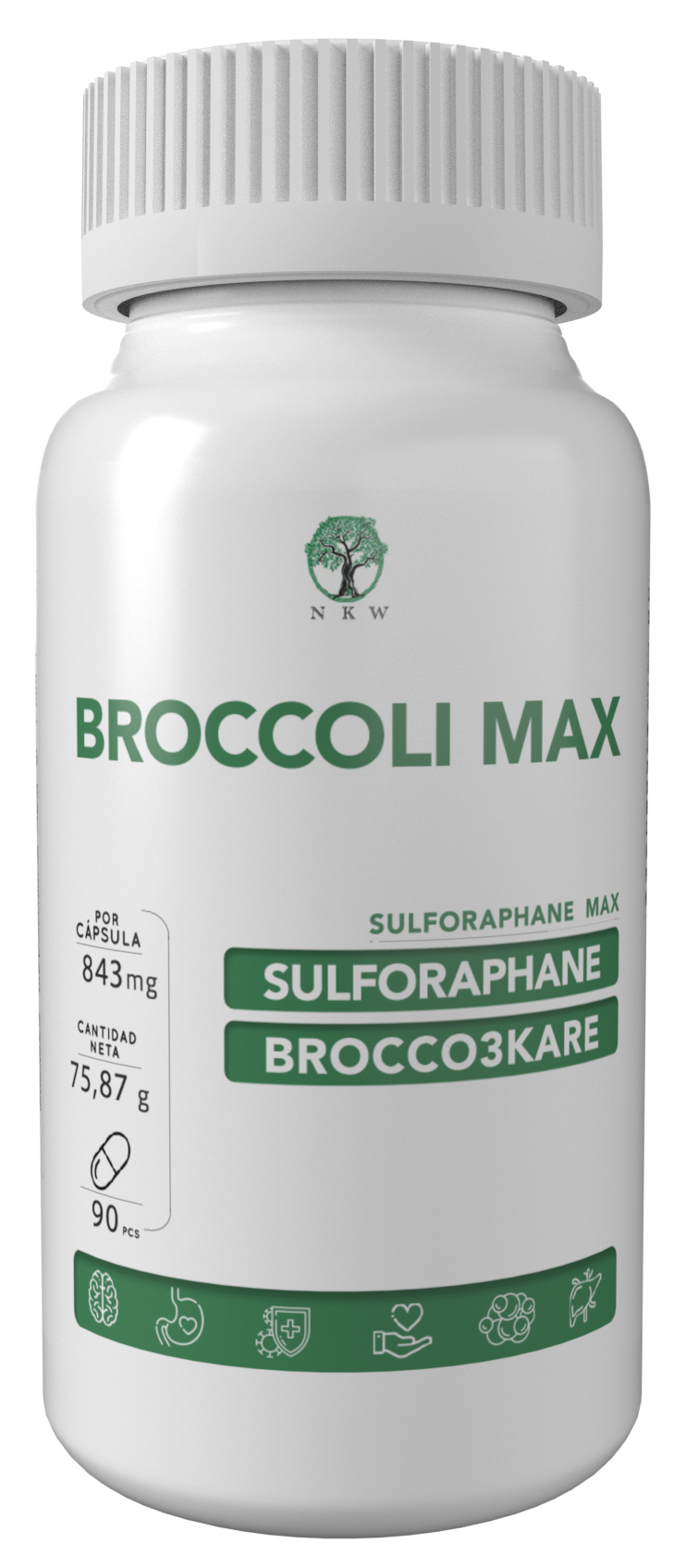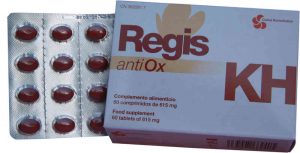PRESENTATION: 90 vegetable capsules
INGREDIENTS: Dry extract of Broccoli (Brassica Oleracea L (in high concentration of active principles; Sulforaphane and Indole-3-Carbinol), Coating agent (hydroxypropylmethylcellulose), anti-caking agents (magnesium salts of fatty acids and silicon dioxide), and Black Pepper Extract (Piper nigrum L).
DIRECTIONS FOR USE: Take one capsule, three times a day, 15 minutes before meals. 100.5 mg of Sulforaphane (in Broccoli extract 1000.5 mg per daily intake). 55.25 mg of Indole-3-Carbinol (in Broccoli extract 1105 mg per daily intake).
TRADITIONAL USE OF ITS COMPONENTS:
A family of vegetables is a source of at least two compounds with recognized effectiveness in cancer treatment: sulforaphane and indole-3-carbinol. These act by stopping the growth of cancer cells, blocking angiogenesis (the formation of new blood vessels necessary for tumor growth), and promoting apoptosis (programmed death of tumor cells).
SULFORAPHANE
Sulforaphane is a natural organic compound that is part of isothiocyanates, molecules that contain a sulfur atom. Sulforaphane is found in cruciferous vegetables such as broccoli, kale, Brussels sprouts, cabbage, bok choy, watercress, arugula, and kale, i.e., plants of the Brassicaceae family. It has been shown to provide many health benefits. Among its many properties:
It has anticancer properties.
Different studies have demonstrated its protective role, within a healthy diet and lifestyle, against some types of cancer such as breast, uterine, prostate, and internal organ cancers like liver, colon, kidneys, and intestines. These anticancer properties are enhanced by its content of vitamin A (in the form of beta-carotenes), C and E, folic acid, amino acids, zinc, iron, and potassium.
Inhibition of angiogenesis and metastasis
Angiogenesis is the process by which new blood vessels are formed and is essential for the growth and expansion of cancer. Sulforaphane can inhibit angiogenesis, thus limiting the supply of nutrients and oxygen to cancer cells. Additionally, it can decrease metastasis, which is the spread of cancer cells to other organs and tissues.
INDOLE-3-CARBINOL
Indole-3-carbinol (I3C) is a phytochemical found in vegetables of the cruciferous family (broccoli, cauliflower, and Brussels sprouts). It is important as an antioxidant and anticancer agent, known since the 1960s for its effect on carcinomas caused by chemical toxins. Currently, we know that indole-3-carbinol can modulate estrogen metabolism.
Indole-3-carbinol appears to work in several ways:
- Facilitates the conversion of estrogen into a less cancer-stimulating form.
- Partially blocks the effects of estrogen on cells.
- Directly eliminates or inhibits cancer cells.
- Reduces levels of free radicals, which can stimulate cancer development by damaging DNA.
A 4-week double-blind, placebo-controlled study with 57 women found that a minimum dose of 300 mg of I3C per day might be necessary to reduce the risk of estrogen-induced cancer. Another study found benefits with 400 mg of I3C per day.
Several in vitro and in vivo studies have demonstrated that it inhibits up to 90% of the growth of tumor cells characterized by the presence of estrogen receptors. It has also proven to be a potent chemopreventive agent for hormone-dependent cancers such as breast, cervical, or prostate cancer. It also inhibits cell growth in breast carcinomas characterized by the absence of estrogen receptors due to its antioxidant action.
In cancer prevention and treatment, it has been proven through nutritional methods that Indole-3-Carbinol and sulforaphane are especially indicated for the following types of cancer:
Lung cancer, partially neutralizing nitrosamines (carcinogenic compounds) present in cigarette smoke. "Hormonal" cancers such as breast and endometrial cancer, opposing estrogens and thus blocking their progression. Stomach cancer, activating antioxidant enzymes in the gastric mucosa, thus protecting it from damage that the H. pylori bacterium could cause to its DNA.
It has been demonstrated that in countries where the consumption of cruciferous vegetables is significant, the incidence of lung, colon, breast, and prostate cancers is much lower.
Indole-3-carbinol is also distinguished by its action against the body's chemoresistance, thus reducing chemotherapy sessions.
Another outstanding property of Indole-3-Carbinol and sulforaphane is their ability to neutralize carcinogenic substances, protecting DNA from chemical damage and thus reducing the risk of developing cancer related to these sources of contamination.
Bibliographical references:
van Poppel G, Verhoeven DT, Verhagen H, Goldbohm RA. Brassica vegetables and cancer prevention. Epidemiology and mechanisms. Adv Exp Med Biol. 1999;472:159-68.
Singh SV, Srivastava SK, Choi S, et al. Sulforaphane-induced cell death in human prostate cancer cells is initiated by reactive oxygen species. J Biol Chem. 2005;280:19911-24. Epub 2005 Mar 11.
Joseph MA, Moysich KB, Freudenheim JL, et al. Cruciferous vegetables, genetic polymorphisms in glutathione S-transferases M1 and T1, and prostate cancer risk. Nutr Cancer. 2004;50:206-13.
Johnston N. Sulforaphane halts breast cancer cell growth. Drug Discov Today. 2004;9:908.
Bradfield CA, Bjeldanes LF. Modification of carcinogen metabolism by indolylic autolysis products of Brassica oleraceae. Adv Exp Med Biol. 1991;289:153 - 163.
Wong GY, Bradlow L, Sepkovic D, et al. Dose-ranging study of indole-3-carbinol for breast cancer prevention. J Cell Biochem Suppl. 1997;28 - 29:111 - 116.
Yuan F, Chen DZ, Liu K, et al. Anti-estrogenic activities of indole-3-carbinol in cervical cells: implication for prevention of cervical cancer. Anticancer Res. 1999;19:1673 - 1680.
Arnao MB, Sanchez-Bravo J, Acosta M. Indole-3-carbinol as a scavenger of free radicals. Biochem Mol Biol Int. 1996;39:1125 - 1134.
Bradlow HL, Sepkovic DW, Telang NT, et al. Multifunctional aspects of the action of indole-3-carbinol as an antitumor agent. Ann N Y Acad Sci. 1999;889:204 - 213.
McDanell R, McLean AE, Hanley AB, et al. Chemical and biological properties of indole glucosinolates (glucobrassicins): a review. Food Chem Toxicol. 1988;26:59 - 70.
Wong GY, Bradlow L, Sepkovic D, et al. Dose-ranging study of indole-3-carbinol for breast cancer prevention. J Cell Biochem Suppl. 1997;28 - 29:111 - 116.
Kelloff GJ, Boone CW, Crowell JA, et al. New agents for cancer chemoprevention. J Cell Biochem Suppl. 1996;26:1 - 28.
Shertzer HG, Berger ML, Tabor MW. Intervention in free radical mediated hepatotoxicity and lipid peroxidation by indole-3- carbinol. Biochem Pharmacol. 1988;37:333 - 338.
Wong GY, Bradlow L, Sepkovic D, et al. Dose-ranging study of indole-3-carbinol for breast cancer prevention. J Cell Biochem Suppl. 1997;28 - 29:111 - 116.
Dashwood RH. Indole-3-carbinol: anticarcinogen or tumor promoter in brassica vegetables? Chem Biol Interact. 1998;110:1 - 5.
Bailey GS, Hendricks JD, Shelton DW, et al. Enhancement of carcinogenesis by the natural anticarcinogen indole-3-carbinol. J Natl Cancer Inst. 1987;78:931 - 934.
Meng Q, Yuan F, Goldberg ID, et al. Indole-3-carbinol is a negative regulator of estrogen receptor-alpha signaling in human tumor cells. J Nutr. 2000;130:2927-293l .
Chinni SR, Sarkar FH. Akt inactivation is a key event in indole-3-carbinol-induced apoptosis in PC-3 cells. Clin Cancer Res.2002;8:1228-1236.
Hong C, Firestone GL, Bjeldanes LF. Bcl-2 family-mediated apopt DIM) in human breast cancer cells. Biochem Pharmacol. 2002 Mar 15;63(6):1085-1097.









Reviews
There are no reviews yet.